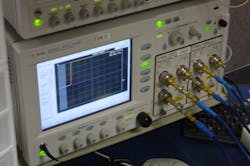Simplify RF IC Testing With On-Chip Thermal Fault Detectors
This file type includes high resolution graphics and schematics when applicable.
Traditionally, it has been difficult and costly to test RF integrated circuits (ICs) under large-scale manufacture. Adding testing and verification to RF ICs also increases manufacturing time and time to market. Attractive alternatives include built-in tests, where the testing operations are on-loaded to take place on the IC itself, or built-in self-tests. If non-invasive fault-detection systems could be integrated within the circuitry of the RF IC, for example, the wafer-level, die-level, and chip-level testing could be simplified in terms of cost, complication, and time. In Grenoble, France, a built-in, temperature-based, non-intrusive sensor for fault detection of a linear amplifier has been designed and tested by Louay Abdallah, Haralampos Stratigopoulos, Salvador Mir, and Josep Altet.
The concept behind their temperature sensor is that minor changes from the target circuit’s ideal operation will cause a different thermal profile than what is expected. This profile can then be monitored and reported on, as long as the thermal sensor is sufficiently robust. A benefit of using thermal-sensing methods is that the sensor’s operation is completely decoupled electrically from the operation of the monitored circuit.
For the temperature sensor, the designers used an open-loop, operational-transconductance amplifier that uses bipolar transistors in a differential configuration. Because the collector current of bipolar transistors has an exponential dependence on temperature, they are suited to applications in which temperature varying operation can occur. Using the two primary bipolar transistors in the differential topology causes a response in the output voltage. Such a response will be dependent upon the temperature, as long as one pair of the differential amplifier’s bipolar transistors are placed near the circuit to be monitored while the other remains relatively isolated. The changes in the transistor’s power dissipation in proximity to the monitored circuit vary with temperature. These changes allow for highly sensitive temperature readings, which do not track with the overall temperature of the bulk IC. See “Defect-Oriented Non-Intrusive RF Test Using On-Chip Temperature Sensors,” 2013 IEEE 31st VLSI Test Symposium, April 2013.
This file type includes high resolution graphics and schematics when applicable.
About the Author
Jean-Jacques DeLisle
Jean-Jacques graduated from the Rochester Institute of Technology, where he completed his Master of Science in Electrical Engineering. In his studies, Jean-Jacques focused on Control Systems Design, Mixed-Signal IC Design, and RF Design. His research focus was in smart-sensor platform design for RF connector applications for the telecommunications industry. During his research, Jean-Jacques developed a passion for the field of RF/microwaves and expanded his knowledge by doing R&D for the telecommunications industry.

